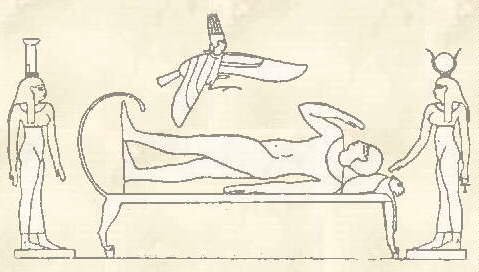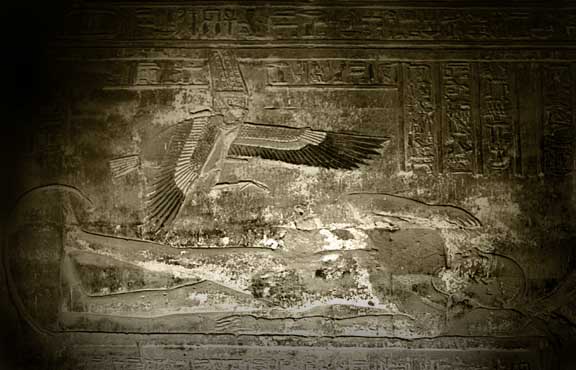
A tentative translation and transliteration, by Geoffrey Graham of some of the hieroglyphs may be found HERE.
SITH Project:Karnak / Temple d’Opet showing the recently restored scene HERE. As of 2021.
Two line drawings showing the entire scene HERE.
A Photograph of the scene
 Photograph © Greg Reeder
1981
Photograph © Greg Reeder
1981
Click on the
image for a large detailed photograph of the scene
Other
scenes of the embrace of the Ba bird with the deceased are helpful in
visualizing this union of Amen-Re with Osiris. Click HERE
for the Ba Bird embracing
the mummy from the Book of the Dead papyrus of Nebseni.
Another portrayal is the Osiride limestone figure from the tomb
of Yuya and Thuya which may be seen by clicking
HERE.
This scene may
have relevance to our understanding of one of the greatest mysteries of
ancient Egypt, the uniting of the dead king with the Ba of the sun god.
"The most decisive divine confrontation encountered in Egyptian religious thought is without doubt between Re and Osiris. As the principle representations of sky and earth, life and death, light and darkness, day and night, they constituted one another's necessary compliment. Without some form of union between them, the Egyptian world view would have been hopelessly divided and the rhythm of life broken." -Jan Bergman.
(unpublished translation from the Swedish by David Lorton from "B3 som gudomlig uppenbarelseform i det gamla, Egypten". Religion och Bibel 29 (1970), p31-32. Kindly provided by David Lorton)
A remembering of Osiris, based on a scene of an ithyphallic Osiris on his lion couch from the Temple of Isis at Philae. Click HERE
SOME OTHER IMPLICATIONS
FOR THIS
mysterium coniunctionis
Some of the implications of this portrayal of the mysterious union of the sun god Amen-Re and Osiris are interesting to contemplate. The temples of this late period were vast libraries of information about ritual and tradition. How much of that knowledge was handed down from most ancient times is open to debate. However the importance of this mystical union between the sun god and the god of the dead dates from the Old Kingdom and was a central mythos in the concept of the divine kingship.
It may offer us real insight into the very purpose of the pyramids and especially just which rituals were performed in such places as the Kings Chamber in the Great Pyramid of Khufu.
"From the Pyramid texts of the Sixth Dynasty (which contain much older religious beliefs...) it becomes clear that the pyramid was not just a tomb, but that it had evolved into the site of a mystery that allowed the dead king to unite with the ba of the sun god."-Dieter Arnold
(Temples of Ancient Egypt, ed. Byron Shafer, Cornell University, 1997 p.47)
This is such a profound and exciting statement that Dieter Arnold writes, for in it is revealed the real meaning of the pyramids..."not just a tomb" and " the site of a mystery". This mystery is a key to understanding the pyramids as sites "that allowed the king to unite with the ba of the sun god."
